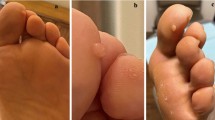Abstract
Acral fibromyxoma is a benign tumor of uncertain differentiation. It is also known as superficial acral fibromyxoma, digital fibromyxoma, and cellular digital fibroma.
Access provided by Autonomous University of Puebla. Download chapter PDF
Similar content being viewed by others
Definition
Acral fibromyxoma is a benign tumor of uncertain differentiation. It is also known as superficial acral fibromyxoma, digital fibromyxoma, and cellular digital fibroma.
Epidemiology and Presentation
This rare dermal-based tumor is typically located in the hands or feet (hence the term “acral”) and especially the digits (with particular regard to the subungual and periungual space). It can occur at any age although most patients are aged 40 years or older, with a slight male predominance. The dome-shaped, polypoid or verrucoid slow-growing nodule can be asymptomatic or painful.
Pathology
The tumor, which is well circumscribed and centered in the dermis, is made of a moderately cellular proliferation of spindled and stellate-shaped fibroblasts arranged in a storiform or fasciculated pattern and included in a myxoid or collagenous matrix with prominent vessels and mast cells. Mitotic figures are usually rare (<1 per 10 HPF); rare multinucleate cells are found in approximately 50% of cases. Usually, nuclear atypia and pleomorphism are minimal, and atypical mitotic figures are absent.
Differential diagnosis may be needed with the following: acquired digital fibrokeratoma (paucicellular, can be CD34 negative); cutaneous myxoma (also known as superficial angiomyxoma; lobulated pattern, poorly demarcated; it may contain an epithelial component; it may be associated with Carney complex); dermatofibrosarcoma protuberans (hands and feet are unusual sites; tight storiform pattern at least focally; infiltrative); benign fibrous histiocytoma (not well circumscribed; typically it does not involve fingers, palms, or soles; CD34 negative); myxoid neurofibroma (no increased vasculature, S100 positive); myxoinflammatory fibroblastic sarcoma (inflammatory myxohyaline tumor of distal extremities; virocyte-like and lipoblast-like bizarre cells, prominent inflammation); sclerosing perineurioma (cells are arranged in corded, trabecular, and onion-skinned whorling patterns; usually CD34 negative and claudin positive); and glomus tumor (it contains smooth muscle cells which are SMAFootnote 1 and MSAFootnote 2 positive).
Biomarkers
Acral fibromyxoma typically stains positive for CD34, vimentin, and CD99 and negative for S100, desmin, MUC4, STAT6, and cytokeratins. Unlike intramuscular or cellular myxomas, GNAS mutations are not present.
Most tested lesions show loss of RB1 expression.
Prognosis
It is a benign tumor, although local recurrences are reported in up to 20% of cases.
Therapy
Surgical excision.
Notes
- 1.
SMA: smooth muscle actin.
- 2.
MSA: muscle-specific actin.
Suggested Readings
Agaimy (2017) Superficial acral fibromyxoma: clinicopathological, immunohistochemical, and molecular study of 11 cases highlighting frequent Rb1 loss/deletions. Hum Pathol 60:192–198
Fletcher (2020) WHO classification of tumours of soft tissue and bone, 5th edn
Paral (2017) Acral manifestations of soft tissue tumors. Clin Dermatol 35(1):85–98
Author information
Authors and Affiliations
Corresponding author
Rights and permissions
Copyright information
© 2021 The Editor(s) (if applicable) and The Author(s), under exclusive license to Springer Nature Switzerland AG
About this chapter
Cite this chapter
Mocellin, S. (2021). Acral Fibromyxoma. In: Soft Tissue Tumors . Springer, Cham. https://doi.org/10.1007/978-3-030-58710-9_10
Download citation
DOI: https://doi.org/10.1007/978-3-030-58710-9_10
Published:
Publisher Name: Springer, Cham
Print ISBN: 978-3-030-58709-3
Online ISBN: 978-3-030-58710-9
eBook Packages: MedicineMedicine (R0)




